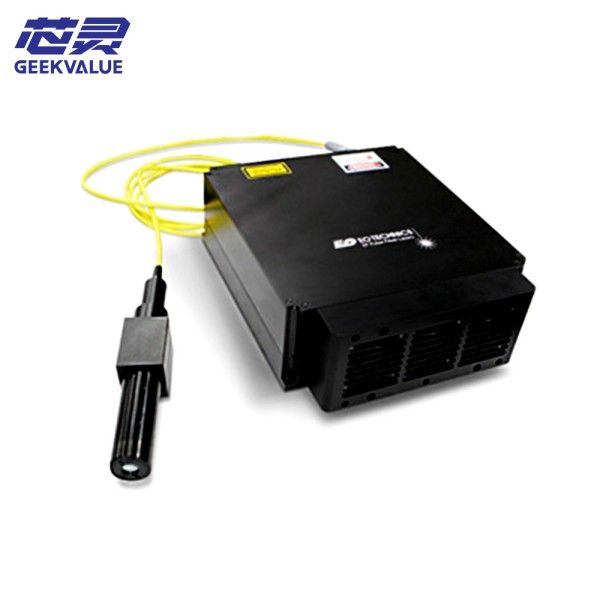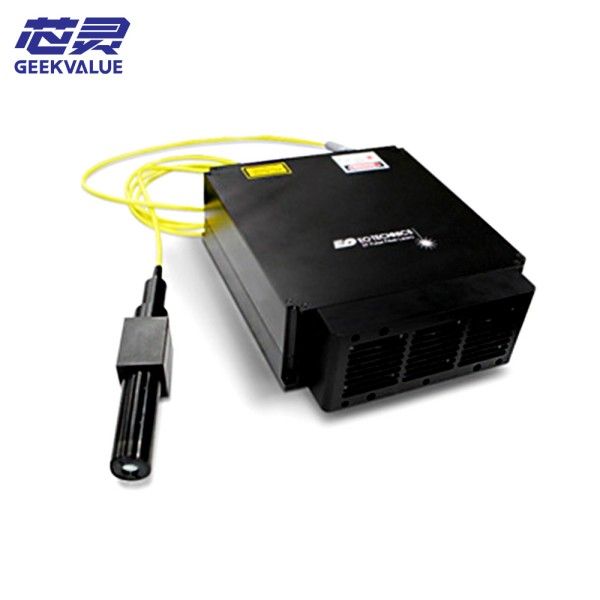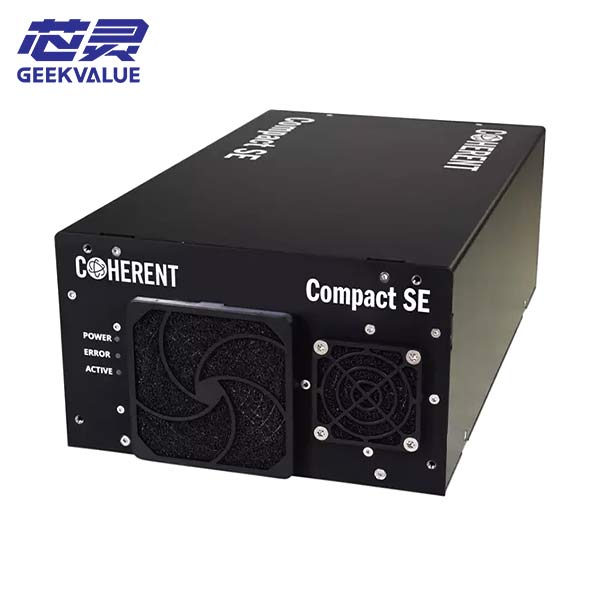EO (EdgeWave) laser EF40 ຫນ້າທີ່ແລະພາລະບົດບາດຄໍາອະທິບາຍລາຍລະອຽດ
EO EF40 ເປັນເລເຊີແຂງລະດັບ nanosecond Q-switched ທີ່ມີພະລັງງານສູງ, ອັດຕາການຄ້າງຄືນສູງທີ່ໃຊ້ເທກໂນໂລຍີ semiconductor pumping (DPSS) ແລະເຫມາະສົມສໍາລັບເຄື່ອງຈັກຄວາມແມ່ນຍໍາຂອງອຸດສາຫະກໍາ, ເຄື່ອງຫມາຍ laser, micro-drilling ແລະຄໍາຮ້ອງສະຫມັກການຄົ້ນຄວ້າວິທະຍາສາດ. ຂໍ້ໄດ້ປຽບຫຼັກຂອງມັນແມ່ນຢູ່ໃນພະລັງງານກໍາມະຈອນສູງ, ຄຸນນະພາບ beam ທີ່ດີເລີດແລະການອອກແບບຊີວິດຍາວ, ເຊິ່ງໂດຍສະເພາະແມ່ນເຫມາະສົມສໍາລັບສະຖານະການທີ່ມີຄວາມຕ້ອງການສູງສໍາລັບຄວາມຖືກຕ້ອງຂອງເຄື່ອງຈັກແລະຄວາມຫມັ້ນຄົງ.
1. ໜ້າທີ່ຫຼັກ
(1) ພະລັງງານສູງແລະພະລັງງານກໍາມະຈອນສູງ
ພະລັງງານສະເລ່ຍ: 40 W (@1064 nm), ບາງຮຸ່ນສາມາດບັນລຸ 60 W.
ພະລັງງານກໍາມະຈອນດຽວ: ເຖິງ 2 mJ (ຂຶ້ນກັບອັດຕາການຄ້າງຫ້ອງ).
ອັດຕາການຄ້າງຫ້ອງ: 1–300 kHz (ປັບໄດ້), ເພື່ອຕອບສະຫນອງຄວາມຕ້ອງການປະມວນຜົນທີ່ແຕກຕ່າງກັນ.
(2) ຄຸນນະພາບ beam ທີ່ດີເລີດ
M² < 1.3 (ໃກ້ກັບຂອບເຂດຈໍາກັດການຫ່າງຈາຍ), ຈຸດສຸມຂະຫນາດນ້ອຍ, ພະລັງງານເຂັ້ມແຂງ.
Gaussian beam, ເຫມາະສໍາລັບ micromachining ຄວາມແມ່ນຍໍາສູງ.
(3) ການຄວບຄຸມກໍາມະຈອນແບບຍືດຫຍຸ່ນ
ຄວາມກວ້າງຂອງກໍາມະຈອນທີ່ສາມາດປັບໄດ້: 10–50 ns (ຄ່າປົກກະຕິ), ເພີ່ມປະສິດທິພາບການປຸງແຕ່ງຂອງວັດສະດຸທີ່ແຕກຕ່າງກັນ.
ຕົວກະຕຸ້ນພາຍນອກ: ຮອງຮັບໂມດູນ TTL/PWM, ເຂົ້າກັນໄດ້ກັບລະບົບຄວບຄຸມອັດຕະໂນມັດ.
(4) ຄວາມຫນ້າເຊື່ອຖືລະດັບອຸດສາຫະກໍາ
ການອອກແບບທັງຫມົດຂອງສະຖານະແຂງ (ບໍ່ມີປັ໊ມໂຄມໄຟ, ຊີວິດ> 20,000 ຊົ່ວໂມງ.
ການເຮັດຄວາມເຢັນທາງອາກາດຫຼືຄວາມເຢັນນ້ໍາທາງເລືອກ, ປັບຕົວເຂົ້າກັບສະພາບແວດລ້ອມການເຮັດວຽກທີ່ແຕກຕ່າງກັນ.
2. ພື້ນທີ່ຄໍາຮ້ອງສະຫມັກຕົ້ນຕໍ
(1) ຄວາມແມ່ນຍໍາຂອງ micromachining
ການຕັດວັດສະດຸ brittle: ແກ້ວ, sapphire, ceramics (ຜົນກະທົບຄວາມຮ້ອນຂະຫນາດນ້ອຍ).
ການເຈາະຈຸນລະພາກ: ກະດານວົງຈອນ PCB, nozzles ນໍ້າມັນເຊື້ອໄຟ, ອົງປະກອບເອເລັກໂຕຣນິກ (ຄວາມແມ່ນຍໍາສູງ).
ການກໍາຈັດຮູບເງົາບາງໆ: ຈຸລັງແສງຕາເວັນ, ITO conductive layer etching.
(2) Laser marking & engraving
ເຄື່ອງຫມາຍໂລຫະ: ສະແຕນເລດ, ໂລຫະປະສົມອາລູມິນຽມ, ໂລຫະປະສົມ titanium (ຄວາມຄົມຊັດສູງ).
ການແກະສະຫລັກພາດສະຕິກ / ເຊລາມິກ: ບໍ່ມີຄາບອນ, ຂອບທີ່ຊັດເຈນ.
(3) ການຄົ້ນຄວ້າແລະການທົດສອບວິທະຍາສາດ
LIBS (ເລເຊີ induced breakdown spectroscopy): plasma ການກະຕຸ້ນກໍາມະຈອນທີ່ມີພະລັງງານສູງສໍາລັບການວິເຄາະອົງປະກອບ.
Laser Radar (LIDAR): ການກວດສອບບັນຍາກາດ, ລະດັບການຮັບຮູ້ຫ່າງໄກສອກຫຼີກ.
(4) ການແພດແລະຄວາມງາມ
ການປິ່ນປົວຜິວຫນັງ: ການກໍາຈັດເມັດສີ, ການກໍາຈັດ tattoo (ຕົວແບບ 532 nm ແມ່ນດີກວ່າ).
ການນຳໃຊ້ແຂ້ວ: ຟອກເນື້ອເຍື່ອແຂງ, ຟອກແຂ້ວ.
3. ຕົວກໍານົດການດ້ານວິຊາການ (ຄ່າປົກກະຕິ)
ພາຣາມິເຕີ EF40 (1064 nm) EF40 (532 nm, ທາງເລືອກ)
ຄວາມຍາວຄື້ນ 1064 nm 532 nm (ຄວາມຖີ່ສອງເທົ່າ)
ພະລັງງານສະເລ່ຍ 40 W 20 W
ພະລັງງານກໍາມະຈອນ 2 mJ (@20 kHz) 1 mJ (@20 kHz)
ອັດຕາການຄ້າງຫ້ອງ 1–300 kHz 1–300 kHz
ຄວາມກວ້າງຂອງກຳມະຈອນ 10–50 ns 8–30 ns
ຄຸນະພາບຂອງລໍາ (M²) <1.3 <1.5
ວິທີການເຮັດຄວາມເຢັນ Air cooling/water cooling Air cooling/water cooling
4. ການປຽບທຽບຜະລິດຕະພັນທີ່ແຂ່ງຂັນ (EF40 ທຽບກັບເສັ້ນໄຍ/CO₂ laser)
ຄຸນສົມບັດ EF40 (DPSS) Fiber laser CO₂ laser
ຄວາມຍາວຄື້ນ 1064/532 nm 1060–1080 nm 10.6 μm
ພະລັງງານກໍາມະຈອນສູງ (ລະດັບ mJ) ຕ່ໍາ (µJ–mJ) ສູງ (ແຕ່ມີຜົນກະທົບຄວາມຮ້ອນຂະຫນາດໃຫຍ່)
ຄຸນະພາບຂອງລໍາ M² <1.3 M² <1.1 M² ~1.2–2
ວັດສະດຸທີ່ໃຊ້ໄດ້ ໂລຫະ / ບໍ່ແມ່ນໂລຫະ ໂລຫະທີ່ບໍ່ແມ່ນໂລຫະ (ພາດສະຕິກ / ອິນຊີ)
ຄວາມຕ້ອງການບໍາລຸງຮັກສາຕ່ໍາ (ການສູບນ້ໍາທີ່ບໍ່ມີໂຄມໄຟ) ຕ່ໍາຫຼາຍຈໍາເປັນຕ້ອງປັບແກັດ / ເລນ
5. ສະຫຼຸບຂໍ້ໄດ້ປຽບ
ພະລັງງານກໍາມະຈອນສູງ: ເຫມາະສົມສໍາລັບການປຸງແຕ່ງຜົນກະທົບສູງເຊັ່ນ: ການເຈາະແລະການຕັດ.
ຄຸນນະພາບ beam ທີ່ດີເລີດ: micromachining ຄວາມແມ່ນຍໍາ (M²<1.3).
ສະຖຽນລະພາບລະດັບອຸດສາຫະກໍາ: ການອອກແບບຂອງລັດທັງຫມົດ, ຊີວິດຍາວ, ບໍ່ມີການບໍາລຸງຮັກສາ.
ຄວາມຍາວຄື້ນຫຼາຍທີ່ມີຢູ່: 1064 nm (ອິນຟາເລດ) ແລະ 532 nm (ແສງສີຂຽວ) ສາມາດໃຊ້ໄດ້ເພື່ອປັບຕົວເຂົ້າກັບວັດສະດຸທີ່ແຕກຕ່າງກັນ.
ອຸດສາຫະກໍາທີ່ນໍາໃຊ້:
ການຜະລິດເອເລັກໂຕຣນິກ (PCB, semiconductor)
ເຄື່ອງຈັກທີ່ມີຄວາມແມ່ນຍໍາ (ແກ້ວ, ເຊລາມິກ)
ການທົດລອງການຄົ້ນຄວ້າວິທະຍາສາດ (LIBS, LIDAR)
ຄວາມງາມທາງການແພດ (ການປິ່ນປົວຜິວຫນັງ, ແຂ້ວ





